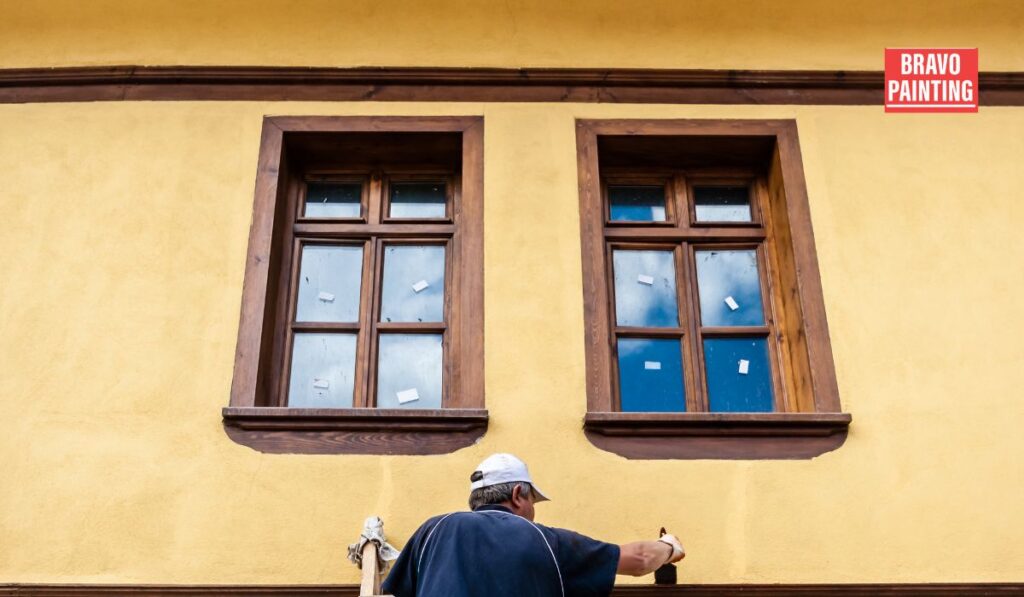Exterior painting is one of the major enhancements to beautify your home.
But what if you can enhance that aesthetic appeal and care for the planet as well?
Eco-friendly exterior painting is not just a trend but a conscious choice, which brings together vibrant colors with sustainability.
With increasing awareness among homeowners of their environmental impact, opting for a green solution is the need of the hour.
So, in this blog post, we’ll explain why eco-friendly paints matter and how they can transform your house exterior without compromising quality or health.
So join us as we dive into sustainable choices leading to a greener home!
Why Eco-Friendly Exterior Paint Matters
Choosing eco-friendly exterior paint helps bring a much healthier environment.
Most traditional paints contain harmful chemicals that can leach into the soil and water supply — a source of pollution.
Therefore, you help to minimize such negative impacts.
In addition, eco-friendly paints are designed to be safer for human and animal health.
Many people underestimate the toxins they would breathe during or after the paint dries.
Non-toxic alternatives minimize risk exposures within your home or neighborhood.
Another aspect of the paints is durability.
The formulations of sustainable paints usually have a longer period of existence than traditional paints, and therefore, less frequent painting occurs.
This saves a lot of resources over the years.
Using eco-friendly paints reflects the value position of a homeowner towards sustainability.
It sends a message that caring for our planet starts at home, inspiring others in your community to make the same choices.
Understanding the Environmental Impact of Traditional Paints
Traditional paints contain harmful chemicals that often greatly impact the environment.
Such components, such as VOCs, are emitted into the atmosphere when applied and dried.
This leads to air pollution and affects individuals’ health in the same space.
When traditional paint is washed off tools or spills occur, it seeps into soil and waterways.
This contaminates the local ecosystems and wildlife by disturbing habitats and food sources.
The long-term consequences of these pollutants can be quite devastating.
Most conventional paint brands also do not formulate using sustainable resources.
As such, they contribute to resource depletion and generate waste that may end up in landfills.
Selecting eco-friendly options helps curb these problems by reducing the toxic emissions and promoting sustainability.
A move towards greener options supports personal well-being as well as environmental health while permitting homeowners to beautify the outer walls responsibly.
Key Features of Sustainable Exterior Paints
These paints have several characteristics that differentiate them from the rest of the paints.
First, they are made from natural ingredients or renewable resources.
This minimizes reliance on fossil fuels and subsequently helps in safeguarding the environment, besides providing more options for the homeowners in the use of houses.
Another major feature is their low or zero volatile organic compounds (VOCs).
Traditional paints release harmful gases into the air, contributing to poor indoor and outdoor air quality.
Eco-friendly alternatives minimize these emissions, making your home healthier for you and your family.
Durability is another key factor.
Environmentally friendly exterior paints tend to last longer and have great weather resistance, which means fewer paint jobs over time.
Long-lasting paint reduces waste in the form of multiple layers of paint.
Moreover, most eco-friendly paints provide high coverage and color retention without compromising performance.
They enable homeowners to have lovely finishes while still caring for the environment in their selections.

Best Eco-Friendly Paint Brands to Look Out For
The most important thing about choosing an eco-friendly exterior painting project is selecting the right paint brand.
Several companies are leading in providing sustainable products that deliver quality and environmental responsibility.
One such line is Benjamin Moore’s Natura line.
It offers excellent coverage without the chemicals, which is great for someone who wants bright colors without compromising indoor air quality.
Behr Premium Plus also excels with its low-VOC formula.
This brand has really combined affordability with performance and is accessible to most homeowners looking to stay green.
You can find many different shades suitable for any home style.
Another noteworthy mention is Sherwin-Williams’ Emerald line.
Known for its durability and washable finish, this eco-friendly option helps maintain your home’s appearance over time while supporting sustainability efforts in the industry.
Low-VOC and no-VOC paints have recently emerged to favor more conscious home-owning, more health-conscious individuals, and those seeking sustainability.
These volatile organic compounds release toxic particles into the atmosphere while trying to dry, leading potentially to respiratory distress, apart from other ailments.
These risks are significantly reduced by choosing low-VOC options, but vibrant colors and excellent coverage are not compromised.
Most manufacturers produce paints with minimal odor, and the painting process is very pleasant for everyone.
No-VOC paints eliminate all these compounds.
It is ideal for families with young children or sensitive individuals to chemicals.
Low-VOC and no-VOC products not only facilitate healthier interiors but are also directed at promoting environment-friendly lifestyles that positively impact our environment in the long term.
Your exterior painting choices may spread ripples toward sustainable living.
Natural Paint Options: Green Alternatives to Chemical-Based Paints
With growing interest in the environment, environmentally responsive homeowners are opting for natural paint options.
Natural paints are from renewable resources like plant oils, clay, and natural pigments.
One of the most significant advantages is that natural paints have a very low impact on indoor air quality.
Unlike traditional paints, which release harmful VOCs, natural paints often contain little to no VOCs.
This means you can breathe easier while transforming your home’s exterior.
Moreover, natural paints offer rich colors, enhancing tones that complement the architectural style.
Earth-toned hues also allow for beautiful harmonization with nature.
Selecting natural paint supports the idea of green practices since they reduce dependence on synthetic chemicals.
By choosing these environmentally friendly alternatives, you are beautifying your home but are also contributing positively to the environment and promoting sustainability in your community.
How to Select the Right Eco-Friendly Paint for Home
Selecting the right paint for the right job starts by determining your surface’s condition.
Make sure that the materials for your painting job support that paint formulation.
Next, consider the colors available in eco-friendly lines.
Green paints have come a long way, but some brands offer limited color palettes compared to conventional paints.
Make sure you find colors that resonate with your vision for your space.
Don’t forget to look for Green Seal or Cradle to Cradle designations on labels.
These seals indicate a product meets stringent environmental standards and can distinguish between products that are just a “green” marketing spin and those that truly are sustainable.
Test samples whenever possible.
Paint can look different once applied on walls than in small swatches.
Sampling helps ensure you’re happy with the color and finish while committing to an environmentally friendly choice for your home’s exterior painting project.
Preparing Your Home for Eco-Friendly Painting
Preparing your home for eco-friendly painting is important to ensure a smooth and successful project.
Begin by removing furniture or outdoor decorations from the area you will paint.
Not only will this protect your belongings, but it also gives you ample space to work.
Examine the exterior surfaces for damage; cracks, peeling paint, or mildew may need repairs before applying new coats of eco-friendly paint.
Remedying these issues sets an excellent foundation for lasting effects.
Cleaning the surfaces also proves important.
A weak detergent mixed with water effectively removes dirt and grime.
Rinse everything extensively and let it dry fully before continuing.
Consider applying painter’s tape on windows and trims for crisp, clean lines and to avoid streaks when applying paint.
Preparing this way will help you succeed with a gorgeous finish without harming the environment.
Eco-Friendly Paint Application Techniques
Applying eco-friendly paint does not require many different techniques from traditional paints.
Still, a few things are necessary to achieve the best results while keeping an eye on the environment.
Prepare the surface by cleaning it well and repairing damages.
This will ensure your chosen paint adheres well to the surface.
Applying eco-friendly paints with good-quality brushes or rollers will ensure minimal streaks and even coverage, making your job easier in the long run.
A primer designed for environmentally friendly products may be necessary, as it can provide better adhesion and durability and result in fewer coats later down the line.
Spray application is the way to go in large areas.
Keep the spray distance controlled to avoid overspray and excess paint usage — a good way to keep things environmentally friendly during your project.
The Benefits of Eco-Friendly Exterior Painting for Long-Term Sustainability
Eco-friendly exterior painting, besides its aesthetic appeal, provides lots of benefits.
Sustainable paints are selected, which minimizes harmful emissions and therefore builds a healthier environment for you and your society.
You are contributing your part to clean air quality through choosing such products.
Another important benefit of eco-friendly paints is their durability.
Many sustainable options are formulated to withstand the elements much better than traditional paints, thus requiring fewer repaints over time.
This saves resources and reduces waste.
Also, using eco-friendly materials can make your home more energy-efficient.
Some eco-paints reflect heat from direct sunlight, which could lower cooling costs during hot months.
Buying green solutions appreciates the value of your home at sale since more buyers want houses that support sustainable features.
Your choice impacts the environment more and positions your real estate positively in a competitive market.
Conclusion
Choosing eco-friendly exterior painting options is a significant step toward creating a more sustainable home.
By choosing paints that prioritize environmental health, you reduce pollution and conserve natural resources.
The benefits go beyond the planet; they also improve your living space.
Eco-friendly paints are often more durable, and your home will look new for years while requiring fewer repainting cycles.
Increasing awareness of environmental issues makes innovative products available in the market.
Homeowners can now enjoy a variety of options tailored to meet aesthetic preferences without compromising ecological values.
Deciding on paint beautifies the home and contributes to making a healthy environment.
It shows concern for sustainability, thus making others realize that they are involved in making a difference within the community.
FAQs
Are eco-friendly paints more expensive?
Not necessarily. Some of the more sustainable options will cost a little more at the start, but in the long term, the savings in terms of durability and reduced maintenance make up for it.
Can I use eco-friendly paint myself?
Absolutely! Many homeowners prefer to take on DIY projects with eco-friendly paints. Just make sure you follow preparation guidelines for the best results.
How do I know if my existing paint is hazardous?
If your home was painted before 2000, it may contain higher levels of VOCs or even lead. A simple test can determine whether upgrading to safer alternatives is time.
Do green paints differ in aesthetics?
Most green paints possess a broad selection of hues and finishes equal to and sometimes better than non-environmentally friendly counterparts.



